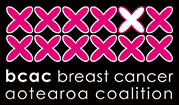UK medicines assessor NICE (National Institute for Health and Care Excellence) has just recommended another combination of drugs for women with advanced hormone-receptor-positive breast cancer. Ribociclib is one of three drugs in the CDK 4/6 inhibitor class, which can extend and improve the lives of women with this type of breast cancer. Ribociclib has been publicly funded in the UK since late 2017, and can now be used with an anti-oestrogen drug called fulvestrant. Clinical trials have shown that this combination could be more effective than ribociclib alone. The UK’s Cancer Drugs Fund will pay for this new treatment so that more data on its effects in the ‘real world’ can be gathered over the next 2-3 years. NICE will then reassess the treatment and see if it should be made available on the NHS (National Health Service).
In New Zealand, only those who can afford to pay thousands of dollars each month can receive a CDK 4/6 inhibitor or fulvestrant. About 61% of New Zealanders with advanced breast cancer are hormone-receptor-positive and without CDK 4/6 inhibitors they have few options left if their cancer advances after hormone therapy. Despite a petition from breast cancer patients last October and appearances before the Health Select Committee this year, there is still no news from PHARMAC, who received applications for a CDK 4/6 inhibitor in February 2018 and fulvestrant in May 2018. During that time, about 550 New Zealanders with hormone-receptor-positive breast cancer have died.
Last month, NICE chief executive Sir Andrew Dillon visited New Zealand. BCAC was there to hear him speak about the UK system.
“The differences between NICE and PHARMAC could not be greater,” said Libby Burgess, BCAC Chair, who noted the following:
- NICE doesn’t have a capped budget – the NHS has a broad indicative target on pharmaceutical expenditure which is quite a different thing. PHARMAC’s budget is capped at an extremely low level.
- If a medicine meets NICE’s transparent, defined cost-effectiveness threshold it is funded. This cost-effectiveness model applies across all of NICE’s activities; it has been refined over time and is now being used in other parts of the UK health system as well. PHARMAC has no defined criteria for funding or threshold over which a medicine will be funded, only a set of loose criteria which are applied as PHARMAC sees fit in any consideration. Medicines recommended by PHARMAC’s committees go onto a waiting list of fundable medicines which may or may not ever be prioritised for funding at periodic confidential PHARMAC staff meetings.
- NICE was set up originally to provide “faster access to modern treatments”. NICE finds 82% of the medicines they appraise to be good value propositions. PHARMAC appears to have been established to control the costs of pharmaceuticals. The small budget means that many of the exceptional medicines prioritised by PHARMAC’s committees remain unfunded.
- 90 days after a European licence is granted for a drug, NICE must provide their advice on whether to fund. PHARMAC operates under no timeframes for considerations or decisions.
- Transparency was mandated as an essential element of how NICE works from its inception. This culture of transparency around medicines funding is inherent in the interactions among NICE, clinicians, the NHS, pharmaceutical companies and patient groups. NICE works hard with companies to be able to say ‘yes’ to funding, with the aim of getting modern medicines to people as soon as possible. PHARMAC has stated that secrecy is a key element of controlling the process and outcomes of interactions with pharma companies. PHARMAC does not provide information to pharma companies to help them understand what they would need to offer to make a drug fundable, or how far from the top or bottom of recommended but unfunded products their medicine sits. PHARMAC processes very often involve long delays of several years and the process appears to be geared to say ‘no’ i.e. to deny the benefits of medicines and refuse funding.
- Cancer has long been a priority for NICE because modern medicines can make such a dramatic difference to patients’ lives. An increasing number of cancers are now becoming chronic diseases because of the provision of effective treatments. In contrast, PHARMAC says it wants long-term gains from investments. Cancer, especially when it is terminal, is absolutely not prioritised.
- All stakeholders including patient advocacy groups have an opportunity for input while a drug is being considered for funding by NICE. Sir Andrew stated that there is no shame in NICE listening to input and changing their view about funding. He stated that NICE will respond to ‘reasoned argument’. In New Zealand stakeholders only get to comment once a deal has been struck and a proposal has gone out – only minor tweaks are possible at that stage.
- NICE delivers on the aspirations of the UK health system. This would not work without a supportive government and a responsive health system. Currently the New Zealand Government appears to be denying there are problems with the current system and claiming that our medicines expenditure of “nearly a billion dollars” is sufficient. With the exception of Mexico, this represents the lowest per capita spend of all 36 OECD countries, is 5% of NZ’s health budget compared with the OECD average of 14% and represents 0.34% of GDP compared with the OECD average of 1.4%.
“Without a full review of PHARMAC and the medicines budget, New Zealand cancer care will continue to lag behind that in other countries” says Libby. “We call on the government to act urgently. New Zealanders are suffering and dying while Health Minister David Clark slowly ponders his plan for cancer.”
27 July 2019



